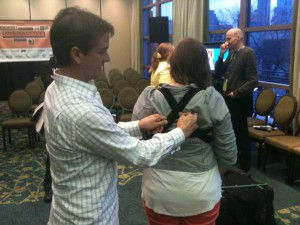In a world where thousands of people work bent over computers every day, the question of office health is especially relevant. Panelists Jason Levitt and Clayton Aynesworth talked about the health risks of sitting and slouching too much, as well as some of the myths that dramatize the dangers of being sedentary at their SXSW panel, “The Comfy Chair! Are We Sitting Too Much?”

The first myth Levitt discussed is the claim that sitting is just as bad as smoking. Many marketing campaigns for health books and standing desks cite this as a fact, but Levitt and Aynesworth clarified that while sitting may have a correlation to negative health effects, it’s extreme to say it is as bad for your health as smoking.
Myth number two is that sitting will lead to early mortality. The reality is that excessive sitting or a sedentary lifestyle can lead to obesity, and obesity leads to higher mortality rates. So while a correlation exists, a person has to do a LOT of sitting, and it’s dramatic to say that sitting will on its own lead to mortality.
Levitt also shared two interesting points from research on the topic.
- Normal, daily activities like walking or going up stairs have a greater impact on overall wellbeing than an hour of exercise per day. So, the old adage that exercising for one hour will counteract an entire day of sitting at a desk is not necessarily true.
- Sitting too much reduces a body’s ability to burn calories. When we sit for a long time, many of our bodies’ functions begin to slow down and become less effective at their respective jobs, whether it’s our organs, skin or posture.
Some alternatives to sitting while working were discussed, such as standing or walking meetings, treadmill desks or software that forces employees to take a break from their computers for several minutes.
Levitt shared more about the importance of understanding the effects of sitting at a desk in the increasingly tech-filled workplace in the below interview:
